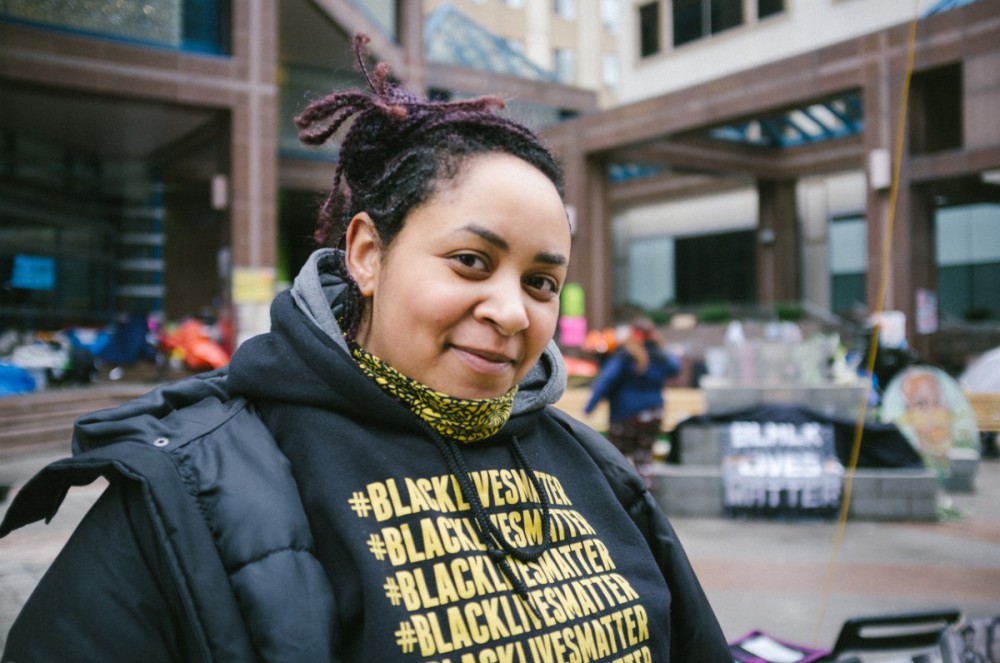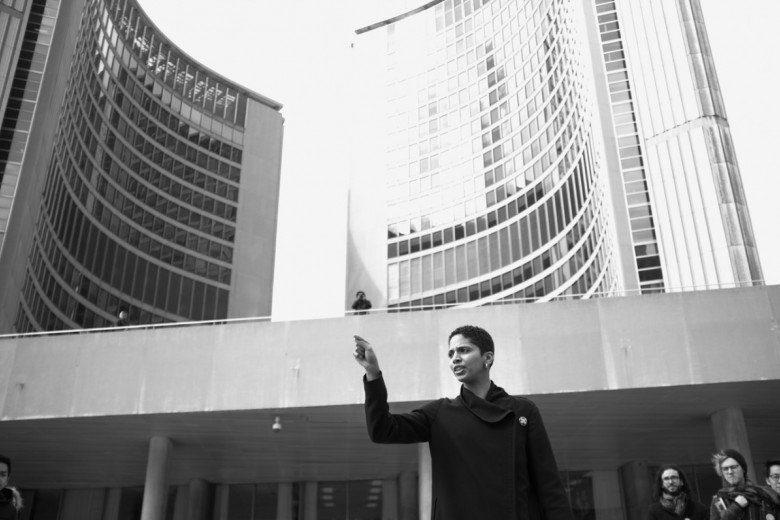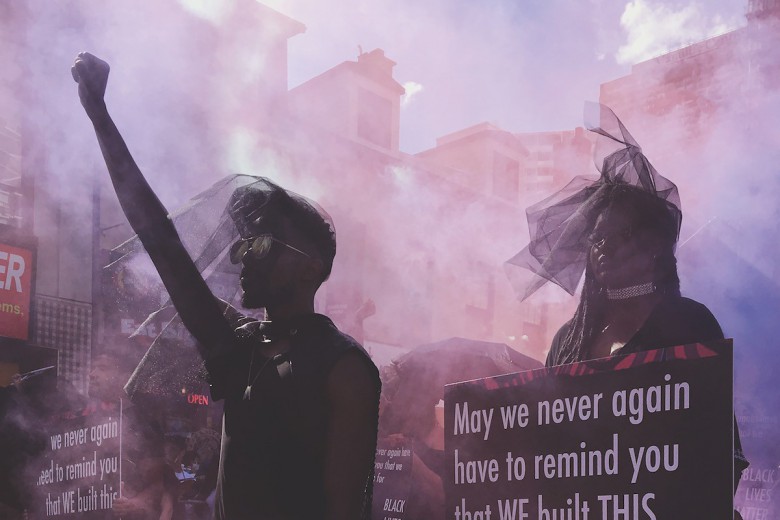Black Lives Matter Toronto (BLMTO) and supporters camped outside Toronto Police Headquarters in the cold, rain, sun, and snow for 15 days.
The peaceful action, referred to as BLMTOtentcity or BLMTO – BLACKCITY, was spurred in large part by news released late Friday, March 18, 2016, that the police officer who killed Andrew Loku in July 2015 would not be charged, nor have their name released to the public.
Two days later, on Sunday night, Black Lives Matter Toronto held a rally with spoken word, dancing, a vigil and food for hundreds of people gathered outside Toronto City Hall. They kept the event going by setting tents up, initiating an occupation.
Under threat of a police raid that night, the group moved camp several blocks to police headquarters. After withstanding a violent attack from police on the second night, the group and supporters remained there for two weeks, bearing frigid temperatures while orchestrating numerous other direct actions.
The occupation ended on Monday, April 4.
A few days later, I asked two members of BLMTO to reflect on their last few weeks. Since conducting this interview, the Government of Ontario announced that it will conduct a coroner’s inquest into the death of Andrew Loku, which was one of BLMTO’s demands.
_LeRoi Newbold and Janaya Khan are on the group’s Steering Committee and participated in BLMTO – BLACKCITY. Khan is also International Ambassador for the Black Lives Matter network. This is the first of a two-part interview. Read Part 2 here
It’s been about a week since BLMTO – BLACKCITY, how are you doing?
LN: I’m doing good. I’m missing BLACKCITY and the community that existed there in that physical location at 40 College Street [Toronto Police Services headquarters]. I am catching up, getting my energy back up for the next steps of Black Lives Matter Toronto.
JK: I’m disoriented. We were moved by – I think – something that was incredibly profound. We carved out a space for a different way of being and a different way of imagining with BLACKCITY.
I wasn’t there for the first few days, and then my team, we were ready to consider calling it and I was like, “This is not the right time.”
So my whole purpose was to come there, to keep it going. And it took over my life. It was exhausting. And it was one of the most liberating things I’ve ever been a part of.
It’s very disorienting to not be there anymore, to not have basic needs at the forefront of my mind. To not have to think about what we’re going to have to do with this crisis or that crisis, or police agitation, or someone having an episode on site, what crisis would be happening at 3:30 in the morning, those are now reserved to the everyday day-to-day things when you’re in this liberation work but it’s not concentrated in the same way.
So I’m grateful, I’m humbled, I’m eager, I’m exhausted, and I’m hopeful for what’s next. I really felt the power of the people in Toronto in a tangible way that I’d never felt before.
What was achieved with BLMTO – BLACKCITY?
LN: So, BLMTO released a list of demands as part of BLACKCITY. We’ve given the city, the province and Toronto Police Services 300 hours [12.5 days] to respond to those demands. [The countdown ends on the weekend of April 16 – 17.] We intend to use the momentum of the community built through BLACKCITY to mobilize, should our demands not be met.
We’ve had some successes in the course of BLMTO – BLACKCITY. On April 1, we mobilized at City Hall, and because of that action a condolences motion was passed for Andrew Loku’s family, as well as a motion to review the SIU [Special Investigations Unit, the provincial watchdog that reviews cases where police injure or kill civilians]. This review will happen from the perspective of looking specifically at anti-Black racism. And although a review is not an overhaul, it is a step in the direction of what we are demanding.
So, holding our elected officials accountable to the public is one way that we mobilize. In terms of our meeting with [Toronto mayor] John Tory and [Ontario premier] Kathleen Wynne, our concern is that these meetings be accessible to our community, that’s the public. We’ve been offered these [private] meetings. We are now working to ensure they are open meetings to our community.

JK: First, I want to emphasize what I mean when I say the culture of organizing is different in Toronto. Grassroots in Toronto is something that lacks a lot of capacity and a lot of infrastructure, and so oftentimes we operate on really minuscule levels and are very dependent on the few granting and funding opportunities that exist.
Three years ago, there wasn’t a place for someone like me, who wasn’t just alternative, but rather very, very militant and very radical. So the idea that a group of people with a vision – that is not completely in alignment but is in alignment around our values and our practices – the idea that we could come together and reimagine what activism could look like and what our relationship to it was incredibly important.
Because here’s the thing about activism: it doesn’t build character, it reveals character.
The challenges that have come up in Toronto have been incredible. And so the idea that, in such a short period of time, a dedicated few could inspire and mobilize people… I think people were ready, they wanted it. They were ready for change and a shift in how we understood each other and justice. And there is now space for militancy and a space for radicalism. And Black Lives Matter is an anchor point in how we understand not just anti-Black racism but liberation as a whole, and so that’s what I mean when I say the culture of organizing has changed.
We really shifted the culture of organizing in the city and made it so there are multiple entry points for people to come into, and that’s incredibly important because there is not one way to do activism. People don’t have to be the most ardent activist every day of their lives, but there are only like two or three moments in your life that make you a superhero. And I feel in so many ways Toronto and so many of us there, we rose to that occasion, so that’s number one.
Second is Black and Indigenous solidarity [discussed in the next question]. Third, I think it wasn’t just an occupation. It was a healing justice space. It was a resource centre. It had programming every day. Fight for $15 came and they had their meeting there. Black Liberation Collective had a meeting there as well. We had movie nights. There were at minimum ten people there every single moment of the day, 3:30 in the morning. We had gospel choirs who would come in and sing to us. People would wander in off the streets to take a look at the art and to make art. So it became a resource centre more than it was an occupation.

In terms of the overall strategy of what BLMTO is doing in Toronto, where is the group now? After BLACKCITY, is it stronger?
JK: Yes. We’re united. We were tight, we always have been. But we’re family. We went through some of the hardest moments of our lives in organizing together and in being around each other constantly, supporting each other constantly, working through conflict constantly, while we’re also navigating the unimaginable … conflict that comes up in the day-to-day just by being Black people in the world and by being queer and trans and Black and women.
Being activists and organizers in a city where anti-Black racism is very real and people’s investment in denial is even realer, we have come out as a unit.
We believe in collectivized self-care where we heal and organize together and take the things that we need and the space that we need in a way that still upholds Black liberation and each other.
Our organizing body has expanded beyond just the steering committee which I think was also critically important. People really rose to the occasion. And a lot of young Black people really rose to the occasion to support the work.
And we have our allies, who have been our strongest support network outside of ourselves.
We have each other’s backs and we know that’s an honour to do that for each other, and we’re committed. And that to me that is also one of the greatest successes. The things that we’ve been through … let me tell you.
LN: And the connections we built with Indigenous communities are very strengthening for us. As well, there was a huge outpouring of support that came from community members throughout BLACKCITY.
So where we’re at right now is counting down the 300 hours, waiting for the response of the city and the province, and planning the next place we’re going to strike should these demands not be met.
What did you learn about Black – Indigenous solidarity from this experience?
LN: Black and Indigenous solidarity was a very powerful component of BLMTO-BLACKCITY. The camp itself was secured by a group of Indigenous Elders who provided physical and spiritual protection. They watched over us while we slept.
One person spoke of the protection that Black people are entitled to under Haudenosaunee law and on Indigenous land. Every morning, Gary flew the Mohawk flag alongside a picture of Andrew Loku. A Two-Spirit Elder came out and recorded a video on site about the connections between police brutality towards that community and missing and murdered Indigenous women. Cathy talked about the history of solidarity between Black and Indigenous community in terms of the role Indigenous people played helping people to cross over through the Underground Railroad.
So the occupation at Toronto Police Headquarters led to the building of many new relationships between Black and Indigenous communities, which was very powerful in and of itself. We’re talking about two communities who are taught through our education system to be ignorant about each other, not to trust each other. The strength of these ties helps us to confront colonialism at the same time as anti-Black racism, which is very important for our politic and our work.

JK: The Black and Indigenous solidarity that was on the ground is going to be instrumental in what mobilizing and organizing in Canada and that part of Turtle Island will look like moving forward. We challenged the myth of “stolen land versus stolen labour,” and rather recognized that these things happen simultaneously.
Our struggles are deeply, deeply linked through colonization and mass incarceration and police brutality and poverty. Our struggles are unique but our liberations are interconnected.
One line that I think we’re really going to take moving forward that is going to change things in really transformative ways is, “Black Lives Matter on Indigenous Land”. I think that that line, and the commitments that were made under it and the relationships that were built there as a result of it, are going to shape how we understand organizing with each other for generations to come.







